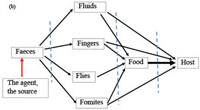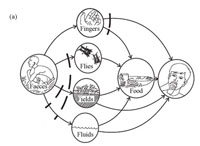1.3.1 Environmental health and disease transmission
The description of diarrhoea transmission represents a good way to understand the pathways of disease through the environment and how environmental health and hygiene can help prevent disease transmission. Figure 1.2 shows the factors that are essential for diarrhoea transmission. (This diagram is widely used to represent these important links in disease transmission. We have included two versions of it here to help you identify it if you see it again. It is used in later sessions in this Module.)
Look first at Figure 1.2 (a). On the left is a person defecating, representing the source of diarrhoea. The infectious agent or disease agent is actively discharged by a patient or carrier of the disease. On the right is the host, who is the person that could be affected by the disease. Between the two, there is the part of the environment that links the two; in other words, the pathway that the disease travels between the source and the host. Now compare Figure 1.2(a) with Figure 1.2(b); you will see they represent the same thing.

Figure 1.2(b) similarly shows the different pathways of transmission through the environment. The source of diarrhoea is the agent or carrier who discharges infected faeces to the environment. To remember the possible pathways we can use the six ‘F’s:
- Faeces: resulting from defecation.
- Fluids: through contaminated water and other contaminated liquids.
- Fingers: contaminated fingers transmit diseases.
- Flies: all sorts of animals such as flies can carry and transmit diseases.
- Fomites or fields: fomites are inanimate objects that carry the infectious agent (e.g. dishes, cups and other contaminated surfaces in contact with food or water).
- Food: infected by fluids, flies, fingers or fomites and then eaten.
A mother had diarrhoea. She was making a meal for her child but did not wash her hands before preparing the food and her child became sick with diarrhoea. Can you identify the source, pathway of disease transmission and the host?
The source is the mother who had diarrhoea; the pathway in the environment is excreta → fingers → food → mouth; and the host is the child.
If you understand the pathway of the disease, then you can design an intervention for the disease that targets the source, environment or the host. An intervention is a way of stopping the disease from being transmitted. The broken lines, in Figure 1.2, indicate the possible interventions for the prevention and control of diarrhoea. Some of these interventions are described in Table 1.2.
| Intervention strategies | Activities |
|---|---|
Intervention at the source (where the diarrhoea infection comes from) |
|
Intervention in the environment (how the diarrhoea infection is transmitted) |
|
Intervention at the host (the person who might become infected) |
|
1.3 Concepts and principles in hygiene and environmental health

